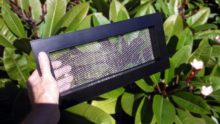How to get rid of raccoons, skunks, opossums or other critters from under your house?

Are EZRvent FV100 vents strong enough to block out Raccoons, Skunks, and Opossum?
Yes, our EZRvent FV100 vents are strong with a continuous heat stake around the perimeter of the vent vs just being spot welded. Our Heavy Stainless option is the strongest option. However, if your raccoons, skunks or opossums are trapped in or young were trapped inside; there will not be much that they will not rip trough; even solid plywood.
How to get rid of raccoons, skunks, opossums or other critters from under your house?
If you have raccoons, skunks, opossums or other critters under your house, you will need to make sure that they have moved on before sealing up all your vents completely. You will also need to retrain them that your house is not a great place to call home within their territory. Until you are able to change this behavior, they will tear through any vent on the market including solid plywood to get back into what they have set-up to be the best house in the neighborhood. You will also need to keep in mind that raccoons, skunks, and opossums are nocturnal and if you seal up your vents during the day, you could be trapping them in. They will also tear through just about anything to get out if trapped in or back in if their young remain inside. Also, if they have young that are too young to move, it will be even more difficult to encourage them to relocate until they are old enough to be moved.
So how do you change their learned behavior and get them to move on and call home someplace else?
The Humane Society is a good source of information for how to encourage raccoons, skunks, opossums and other critters to relocate and discourage them from wanting to return in the future. The Humane Society discourages the use of traps for catch & release after relocating. This places the critters into unfamiliar territory and separates the family unit, both being detrimental to their survival.
Humane alternatives are to simply make the area an undesirable location for the raccoons, skunks, or opossums to not want to live there and want to move out. They will also remember that your location was a bad hotel and be less likely to want to return.
EZRvent Installers and DIY customers have reported having good luck by simply lighting up the spaces with bright work lights. If that is not effective, following the methods prescribed by the Humane Society usually does the trick: “If you can’t wait for the animals to leave on their own, the next best strategy is humane eviction— gently harassing the animals so they’ll move to an alternative location. Wild animals have a sophisticated knowledge of their home ranges—the area in which they spend almost their entire life.” “Litters can, and will, be moved if disturbed” to a more hospitable location. “Try using a combination of unpleasant smells and sounds. The size of the
If the animals are not causing damage or harm, you can be assured that once the young are big enough to be out and about, the birth den will have served its purpose. The denning and nesting season is short. Be tolerant and wait a few weeks until the family has vacated the premises and you’ll prevent orphaning of the young altogether. Then, you can make repairs to prevent animals from moving in again.
If the critters are doing active damage, more aggressive methods that include pepper sprays such as Critter Ridder and or other repellants could be also used.
Before completely sealing up their access points you will want to make sure they have moved on. Otherwise, they will tear through just about anything to get back their young and or out if trapped in. Most sources recommend temporarily closing up openings by stuffing the openings that they were using with newspaper. This will tell you is they are still using that opening if the paper blockage is disturbed. Or, our preferred method is to just place or wedge your EZRvents into place temporarily with shims (without screwing them in) for the first several weeks. That way they could be pushed out if you have trapped a skunk or raccoon inside.
Links to information and tips from the Humane Society:
- http://www. hum anesociety.org/animals/resources/tips/scrap_the_trap.html
- Raccoons: http://www.humanesociety.org/animals/raccoons/tips/solving_problems_raccoon.html
- http://www.humanesociety.org/animals/raccoons/tips/raccoon_eviction_exclusion.html
- Skunks: http://www.humanesociety.org/animals/skunks/tips/solving_problems_skunks.htm
